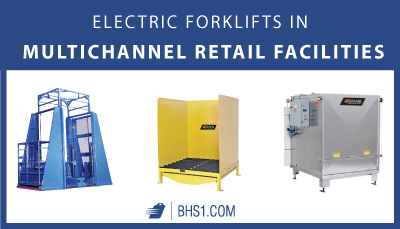We use cookies to make your experience better. To comply with the new e-Privacy directive, we need to ask for your consent to set the cookies. Learn more.
Electric Forklifts in Multichannel Retail Facilities
Brick-and-mortar retailers that run e-commerce channels out of existing stores have a competitive advantage, especially if they operate multiple locations. The combined retail space/distribution center offers retailers incredible access to customers, whether they're picking items up in the store or having them shipped directly.

There is one challenge, however: Space. The retail store and the distribution center have totally different requirements. Public retail facilities face serious space restrictions that can affect their ability to operate e-commerce channels from the same building customers visit to shop, or to collect orders they made online.
The problem is especially challenging in the case of material handling equipment. Small warehouse spaces still need room to operate forklifts, and to handle full pallet loads of products.
Electric forklifts are the clear choice for multichannel applications, which are likely to be indoors. But electric forklifts also require battery rooms, and multichannel retailers may face challenges finding the space to store, charge, and maintain these vital components.
Here are a few ways to handle and maintain forklift batteries in a smaller, dual-purpose facility:
-
Build up, not out.
As with warehouse racking generally, the key to efficient use of space is to utilize the entire cube. Multi-tier battery stands with corresponding Battery Extractors allow users to store large collections of forklift batteries in the smallest possible footprint.
-
Speed up battery changes to avoid congestion.
With space at a premium, it's important to keep trucks moving in and out of the battery change-out area as quickly as possible. Otherwise, operators will find themselves sitting in line before they can even start a shift.
-
Integrate maintenance equipment into battery stands.
Haphazard design in the battery room is easy to spot. Some warehouse managers add equipment over time, placing watering systems and wash stations wherever they'll fit.
In the hands of a trained user, Battery Extractors from BHS complete change-out in just a few minutes. Even Quad Stack Battery Extractors, which travel vertically up to four tiers to access batteries, move with enough speed and precision to change batteries as quickly as possible, without compromising on safety.
This inefficient use of space complicates the routine maintenance that forklift batteries need for long, dependable service life. The solution is to integrate Wash Stations or Wash Cabinets directly into the stands, where Battery Extractors can easily access them.
Optimal use of space is the key to operating a distribution center out of a facility that was built simply for direct-to-customer retail. There are plenty of advantages to this dual-use approach, as well.
Aggregating inventory at a single location ensures items will be available, whether customers find them on the shelves, order online with delivery, or buy online and pick up in the store. Offering every possible channel to customers can help traditional retailers thrive in the digital era. With a well-designed battery room, electric forklifts can provide the material handling capacity it takes to successfully operate a multichannel retail facility.
References:
Cosgrove, Emma. "Think fast, think small." SupplyChainDive. Industry Dive, 4 Sept. 2018. Web. 21 Sept. 2018.
